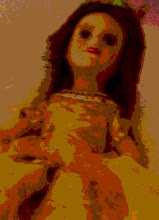I haven't so much studied the history of quilting as been exposed to it by my efforts to find ideas for quilts to make. Also, some of my quilt group are quite active in shows and all (I'm just a diletante), so I've become aware of the continuing changes in the art and craft of quilting. Mostly I've noticed that through it's history, it's had two very distinct pieces which have developed independently as well as together and have come into conflict as their paths have become more intertwined.
Quilting came long before piecing (patch-working multiple fabrics together), a way of creating padding for under armor in the middle ages, elaborate and decorative stitching on white or other solid-colored fabric.
Patchwork blankets and such seem to have come along later and from a much different direction, literally patching on existing blankets, or simple blocks tied to other layers with stitching only around the edges. Somewhere in the 19th century, the two came together into stitched, colorful quilts in any number of patterns and colors, or crazy unpatterned mixes blended together with underlying color themes or embroidery.
The quilting part of the mixed quilts, though, still remained a thing of it's own, sometimes playing a dominant role in simple pieced quilts, sometimes a minor role, doing barely more than hold top and bottom and batting together. In most cases it seems, the top was pieces and the whole quilted by the same person, sometimes with the very same stitches (certain kinds of applique), but often separate, with no one ever perfectly satisfied on how much the piecing and quilting should be related, whether the quilting can be an overall pattern independent of the colors and shapes of the top, whether the stitching should follow the piecing exactly or in echo, or to what degree a bit of both might apply as space filler, to decorate the back, or as a different art sharing the space.
It's not always a craft for one, however, and some quilters prefer one part and some the other and some think the two should be inter-related in a way hardly possible without a single vision by a single artist. Early and late and places in between, the roles have been separated. Quilting bees, for example, were almost always about one person's top being put together by a group of quilters. These days, with machine quilting available with large and very expensive machines, many top-makers have someone else do the quilting. With it again comes the potential for conflict, as the top maker and the quilter have different visions of the end product. And these days, quilting threads come in a lot more colors, and multiple colors. There is no set tradition of blending with the colors of the fabric, back or front, and a often as not a contrasting color might be chosen to make the quilting stitches and their patterns more visible. With machine quilting, there's also more ease involved in using lots more quilting than is needed to put the top, batting, and backing together than when quilts are hand quilted.
And at the same time, sewing techniques possible only with a machine allow much more complex piecing, too. Can both the piecing and the quilting be strong and complex without causing chaos? Should the quilting enhance the piecing, or can the piecing, however difficult and complex and artfully created be little more than a colorful canvas for the complex and artfully contrasting colors of an elaborate quilting design? If the quilter wants to do elaborate patterns, couldn't they jut go back to the beginning and use a single-color fabric? What about the two crafts draws them ever back to each other like the proverbial opposites?
Friday, February 10, 2012
Subscribe to:
Post Comments (Atom)

No comments:
Post a Comment